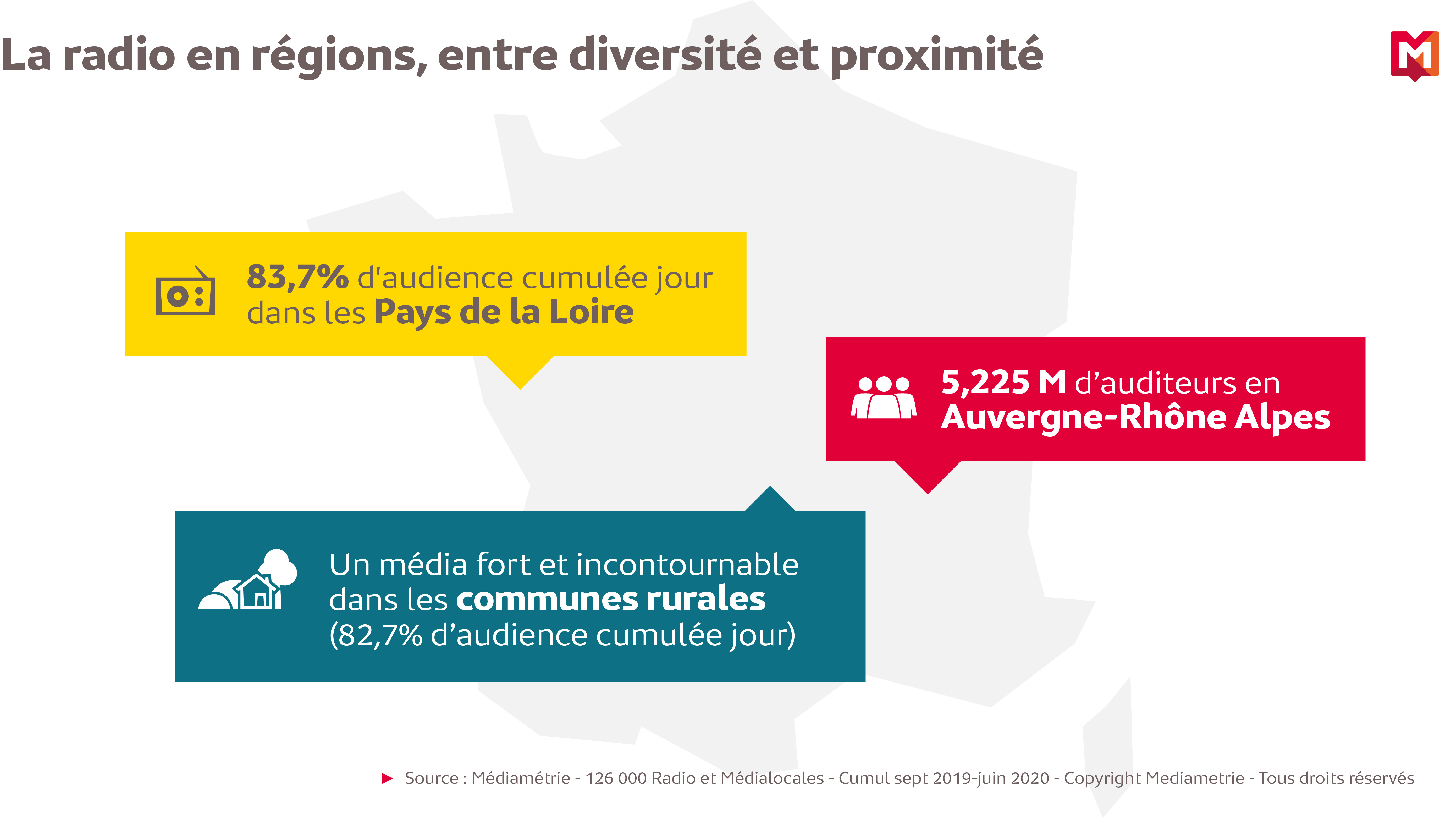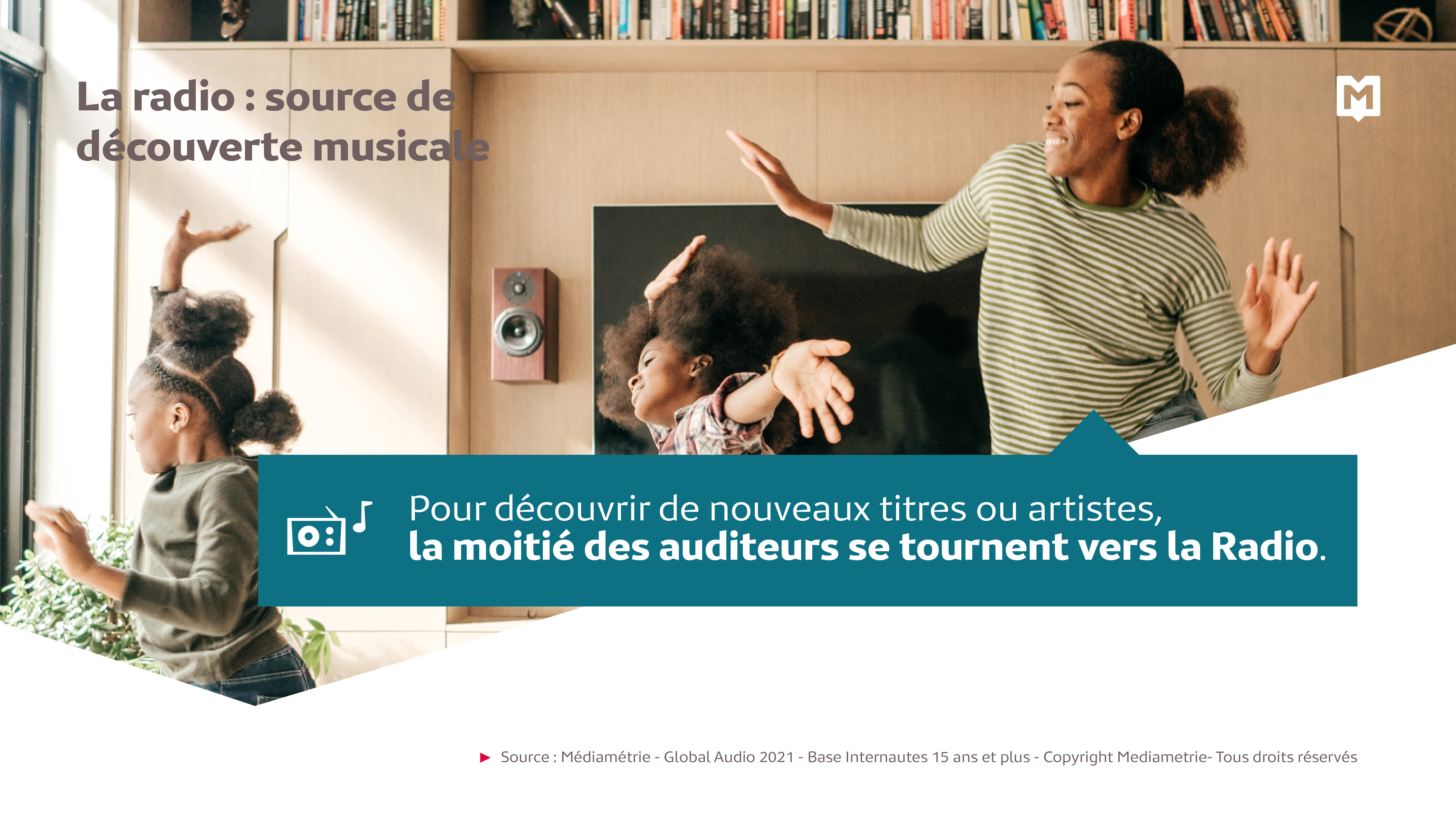- Accueil
- Résultats & Repères
- Music, podcasts and proximity: the radio's key strengths
Music, podcasts and proximity: the radio's key strengths

Estimated reading time : 7 min 48 s
100 years after it was created, radio is the companion for over 40 million pairs of ears for almost three hours of each day in France. On the occasion of the CSA conference entitled: “La Radio fait son show” on June 1st, Médiamétrie – the only stakeholder to offer a consolidated and accurate view of media consumption – focused on three aspects of the radio: its key role in discovering new music; its capacity for innovation through podcasts; and its community roots via local stations.
Radio, at the heart of music in a new listening age
Music is part of the fabric of life for the French: almost three quarters of them listened to music on a daily basis. And the radio was always their first port of call. Radio accounted for almost half (44%) of music listening, ahead of streaming and video platforms, followed by personal music collections. It is worth noting that radio offers a very wide range of music: local and national stations, themed internet versions of the same, and also internet radio. The primary reason listeners turned on the dial was to listen to music!
Radio plays a key role in discovering new music: listeners felt that the radio was their main source for new songs. Half of listeners preferred radio for discovering songs and artists and following music news; slightly fewer than 1 in 3 listeners (30%) used music streaming platforms for this. Whenever they were undecided on which music to listen to, 38% of listeners turned on the radio and 30% launched a music platform. Médiamétrie gathered the opinions of the listeners: they spoke of "allowing the radio stations and their hosts to surprise them", "leaving the musical selection to the pros", and mentioned trust in radio and in a "host's selections for a quality playlist".
Emmanuelle Le Goff, Director of Médiamétrie's Radio and Overseas Department, explained further: "The listeners we interviewed also said that they were looking for a certain atmosphere, one that is embodied by the different styles on the radio. Naturally, the human factor was key, both through the intervention of a fun, friendly voice from time to time, and through the notion of sharing with the other listeners."
This was borne out by the figures: every day, nearly 18 million people aged 13 and older listened to national music stations, and over 9 million listened to local stations, for an average listening time of more than 1hr 45mins. These listeners were younger than the average radio listener and younger than the population as a whole. More than two-thirds of listeners to music stations were in the working population.
Indeed, listeners increasingly tuned in to music stations via digital devices, particularly smartphones: these accounted for almost one-fifth of listening.
Music and local stations accompanied listeners throughout the day. For the most part, they listened to these stations away from home, in the car or on public transport, but also in the workplace or place of study.

Podcasts - an increasingly indispensable format
Radio stations were the pioneers of podcasting. Their catch-up services allowed us to listen again to shows that had previously been aired on the radio. Stations also increasingly developed original, so-called native podcasts that were only available online.
Médiamétrie detects and deciphers the growing use of digital in France, and its research has confirmed that more and more radio fans are converting to podcasts: 15 million French people listened to podcasts each month, that's almost one-third of internet users (31%).
Each month, 28% of internet users listened to radio station podcasts (listen again and original podcasts); 12% of internet users listened to original podcasts from independent creators or from other TV and press media.
Podcast streams and downloads[1] demonstrated the vitality and growth of this format: in April 2021, nearly 113 million podcasts were streamed or downloaded on platforms subscribing to Médiamétrie's eStat Podcast measure. That was a 15% increase on the same period a year earlier.
Younger people were the keenest podcast consumers: on average over a month, one-half of 15 to 24 year olds listened to the format. That surpassed the average proportion of all internet users listening to a podcast each month, which was closer to one-third (31%).
Young children were also adopting podcasts influenced by their parents – nearly 70% of podcast listeners with children under 13 years old had introduced them to podcasts. Future fans in the making!
Julie Terrade, Director of the National division within Médiamétrie’s Radio department, explained: “Podcasts offer engaging and stimulating content for listeners. Almost half of them (44%) said they would recommend or rate podcasts. Young podcast listeners were even more likely to recommend this type of audio content (61%)."
Naturally, when it comes to discovering new podcasts, listeners will trust the website or app which they already use, but they might also look to social media and word-of-mouth recommendations.
For young listeners, social media were the primary drivers for discovering new podcasts, ahead of websites and apps; in third position, they put their faith in the recommendations of celebrities and YouTubers.

Radio: the proximity media
Another crucial aspect of radio is the notion of geographical proximity, with listeners showing great interest in local news and expressing a need to connect with their immediate surroundings.
The radio landscape in France presents an array of formats, universes, and themes that are available right across France and its overseas territories. More than 1,000 FM stations have been joined by new stakeholders such as internet radios and DAB+ pure players, signalling the diversity and proximity that exist across French territory.
More than 9 million people (9.3) listened to local programming on a daily basis, whether via commercial or association radio stations in very mixed transmission areas. On average, such listeners tuned in for 1hr 45mins a day. Therefore, these stations accounted for almost 15% of the total audience.
In addition to these stations, one other local radio network exists:
- France Bleu, which boasts over 3.3 million daily listeners.
- A significant number of national radio networks hand over to local presenters for advertising, news flashes and special transmissions.
The Ile de France region numbered 7 million daily listeners to local programmes.
Traditionally, the radio is most listened to in the West of France: the highest audiences over the last season (from September 2019 to June 2020) were recorded in the Pays de la Loire, with a cumulative audience of 83.7%; in Brittany and Normandy, radio audiences also topped 80% (80.4%).
Conversely, France's south-eastern regions (PACA, Corsica, Occitanie) set bak.
Due to its administrative divisions and regions that vary in population density and size, the Auvergne-Rhône Alpes region is the most important region outside Ile de France, with 5.2 million daily listeners.
Such regional disparities can be explained by several factors: an historically large availability of FM frequencies, the socio-demographic composition of these regions (in particular, the proportion of employed individuals), and the climate, but also traffic, road networks, key public transport infrastructure, etc. Listeners also proclaim their strong local or regional identity.
Local media have leveraged digital technology to expand and grow, even reaching out to individuals who had moved away from their home region. They also forged stronger interactions with listeners.
Guy Détrousselle, Médiamétrie’s Director of local media, concluded: "Diversity is about much more than administrative divisions; the Regions are rooted in their history, culture and identity: we talk about territories, and even 'lands'. Radio's diverse offering lets the audience come even closer to these local realities. These days, the key drivers of radio are the Regions and rural municipalities in particular."
Sources: Médiamétrie - Global Audio 2021 – Base: Internet users aged 15 years and over –
126 000 Radio and Médialocales - Cumulative for September 2019 to June 2020
eStat Podcast March 2021 volume / number of podcasts downloaded each month, based on measured stakeholders
Copyright Médiamétrie - All rights reserved


Three questions for Hervé Godechot, member of the Conseil Supérieur de l'Audiovisuel (France's higher council for the audio-visual sector)
What does radio mean to French audiences?
Radio is the preferred media for French people. The ratings prove it: over 40 million people listen to the radio each day for 2hrs 45 mins! Radio is with us everywhere, at every moment of our daily life, at home, in the car, on public transport, even at work... Listeners trust that the radio will entertain and inform them.
What are radio's strengths in the digital universe?
Longevity is one of its assets – everyone is used to the radio. With more than 1,000 stations, the prolific choice on offer is an indisputable strength in the face of competition from new media and new consumer practices. Listeners are sensitive to the human aspect of radio: its spoken word formats, music recommendations, etc. are delivered by professionals whose sensitivity, and culture could never be replaced by an algorithm. Radio is the media of intimacy and emotion.
In what directions do you think radio will grow in the years and decades to come?
Enthusiasm for radio should not obscure the challenges facing the sector. Audiences have been declining for several years. Younger listeners are switching to other media, and the advertising market is being eroded. Radio has to reinvent itself. Starting with technology: the roll-out of DAB+, digital terrestrial radio, is a considerable asset to win back audiences, especially the youngest: enhanced quality of listening and reception, an even wider offering, greater environmental consideration... By the end of 2022, more than half of the French population will live in an area covered by DAB+, with about fifty stations available on average. Radio stations also need to invest heavily in digital: they are already present on app stores, and some are available through smart speakers, as well as via Radioplayer France. Podcasts are likely to be new growth drivers. Publishers will also have to consider new business models: on-air advertising will not last forever as the only income for a radio station. Stations will have to explore new revenue streams. In the years to come, many questions will be asked surrounding the intermediation and remuneration of radio shows. Finally, in a world where everything is always at our fingertips, consideration of content and editorial policy will be vital. The CSA is very attentive to all these developments and is supporting the sector through these changes. The question is: what can the radio offer to differentiate itself from other media and to ensure that it lasts in the hearts and minds of French people?
Laure Osmanian Molinero
des médias
édition
définitions
